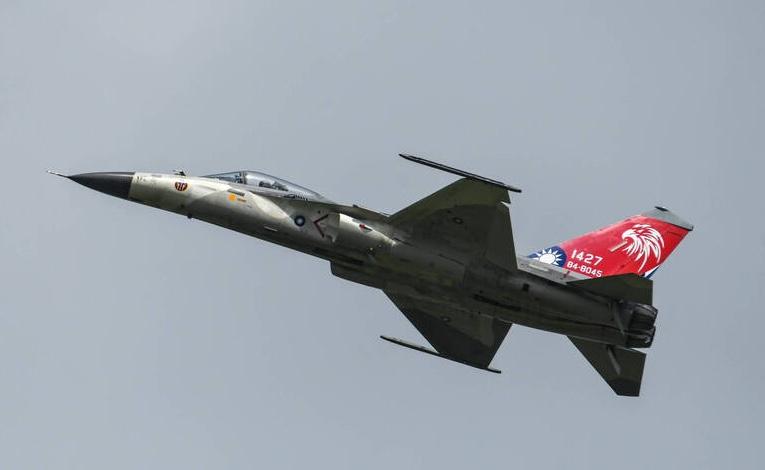A master sergeant died this morning after being sucked into an engine during a routine inspection of a fighter jet at an air base in Taichung, the Air Force Command Headquarters said.
The officer surnamed Hu (胡) was conducting final landing checks at Ching Chuan Kang (清泉崗) Air Base when she was sucked into the jet’s engine for unknown reasons, the air force said in a news release.
She was transported to a hospital for emergency treatment, but was unable to be revived, it said.

Photo: Taipei Times
The air force expressed its deepest sympathies over the incident, and vowed to work with authorities as they investigate.
It also vowed to assist Hu’s family with bereavement matters, and said it would conduct a thorough review to improve work procedures in the hopes of preventing a recurrence.
According to reports, Hu had served in the military for about 17 years.
The incident reportedly occurred when Hu was setting up wheel chocks to keep an Indigenous Defense Fighter (IDF) in place after it had landed.
An expert with knowledge of the matter expressed disbelief, saying in a private and anonymous capacity that the chance of a ground crew member being sucked in by an IDF engine is “miniscule.”
After the plane lands, the motor speed is on a slow “standby” rotation and should have stopped by the time wheel chocks were being deployed, they said, adding that there would not have been time to pick up speed fast enough to pull anyone in.
In addition, the engine intake opening on the IDF is relatively small, especially compared with the single-engine F-16, with two smaller engines on either side of the fuselage that would not be large enough to fit an adult person, they added.
The source also said it should not be difficult to investigate, as security cameras are installed in the hangar.

SHIPS, TRAINS AND AUTOMOBILES: The ministry has announced changes to varied transportation industries taking effect soon, with a number of effects for passengers Beginning next month, the post office is canceling signature upon delivery and written inquiry services for international registered small packets in accordance with the new policy of the Universal Postal Union, the Ministry of Transportation and Communications said yesterday. The new policy does not apply to packets that are to be delivered to China, the ministry said. Senders of international registered small packets would receive a NT$10 rebate on postage if the packets are sent from Jan. 1 to March 31, it added. The ministry said that three other policies are also scheduled to take effect next month. International cruise ship operators

HORROR STORIES: One victim recounted not realizing they had been stabbed and seeing people bleeding, while another recalled breaking down in tears after fleeing A man on Friday died after he tried to fight the knife-wielding suspect who went on a stabbing spree near two of Taipei’s busiest metro stations, Taipei Mayor Chiang Wan-an (蔣萬安) said. The 57-year-old man, identified by his family name, Yu (余), encountered the suspect at Exit M7 of Taipei Main Station and immediately tried to stop him, but was fatally wounded and later died, Chiang said, calling the incident “heartbreaking.” Yu’s family would receive at least NT$5 million (US$158,584) in compensation through the Taipei Rapid Transit Corp’s (TRTC) insurance coverage, he said after convening an emergency security response meeting yesterday morning. National

PLANNED: The suspect visited the crime scene before the killings, seeking information on how to access the roof, and had extensively researched a 2014 stabbing incident The suspect in a stabbing attack that killed three people and injured 11 in Taipei on Friday had planned the assault and set fires at other locations earlier in the day, law enforcement officials said yesterday. National Police Agency (NPA) Director-General Chang Jung-hsin (張榮興) said the suspect, a 27-year-old man named Chang Wen (張文), began the attacks at 3:40pm, first setting off smoke bombs on a road, damaging cars and motorbikes. Earlier, Chang Wen set fire to a rental room where he was staying on Gongyuan Road in Zhongzheng District (中正), Chang Jung-hsin said. The suspect later threw smoke grenades near two exits

The Forestry and Nature Conservation Agency yesterday launched a gift box to market honey “certified by a Formosan black bear” in appreciation of a beekeeper’s amicable interaction with a honey-thieving bear. Beekeeper Chih Ming-chen (池明鎮) in January inspected his bee farm in Hualien County’s Jhuosi Township (卓溪) and found that more than 20 beehives had been destroyed and many hives were eaten, with bear droppings and paw prints near the destroyed hives, the agency said. Chih returned to the farm to move the remaining beehives away that evening when he encountered a Formosan black bear only 20m away, the agency said. The bear